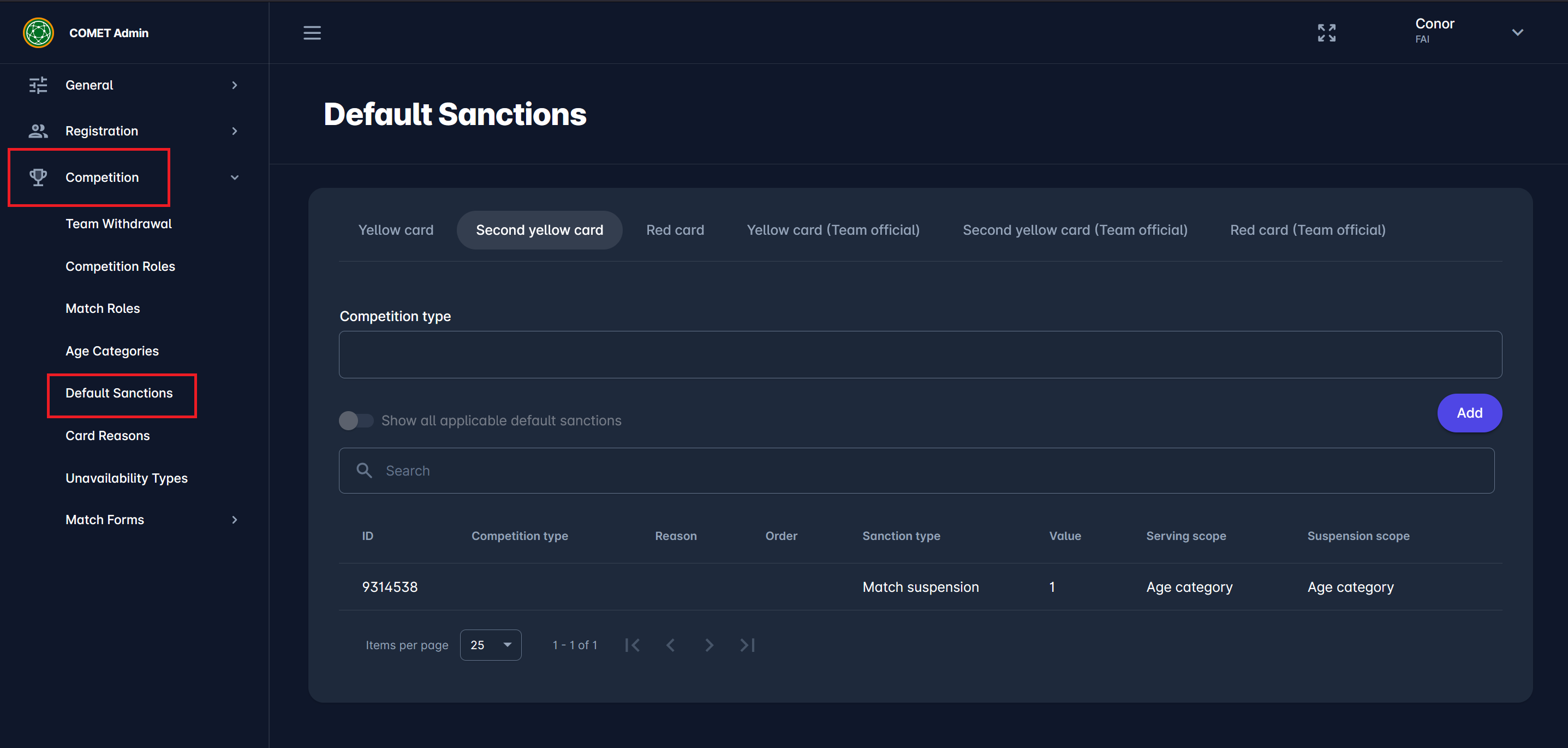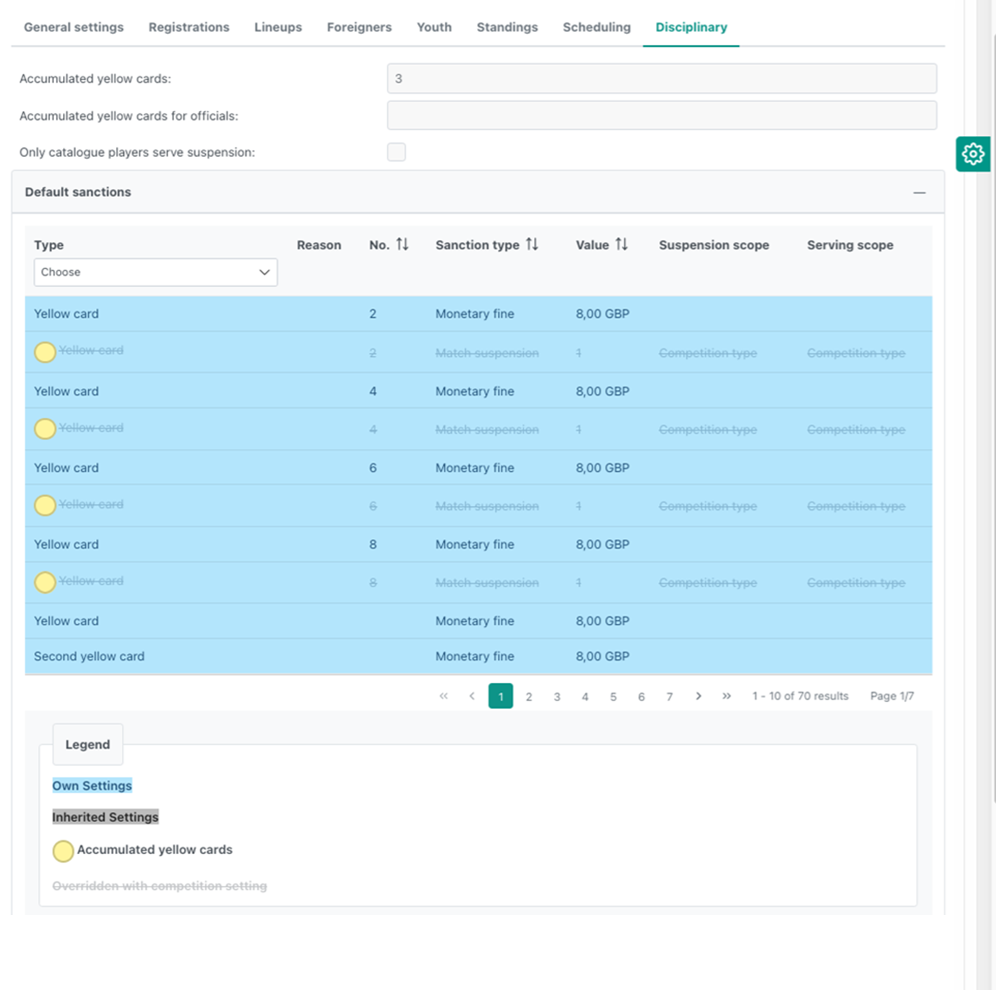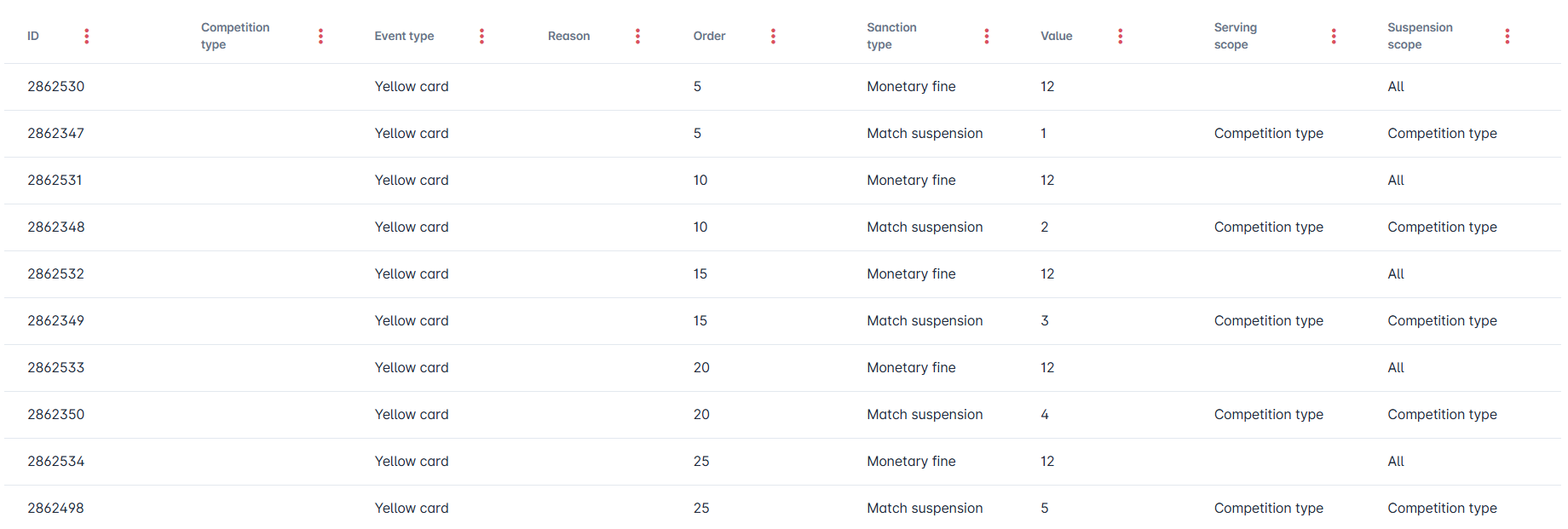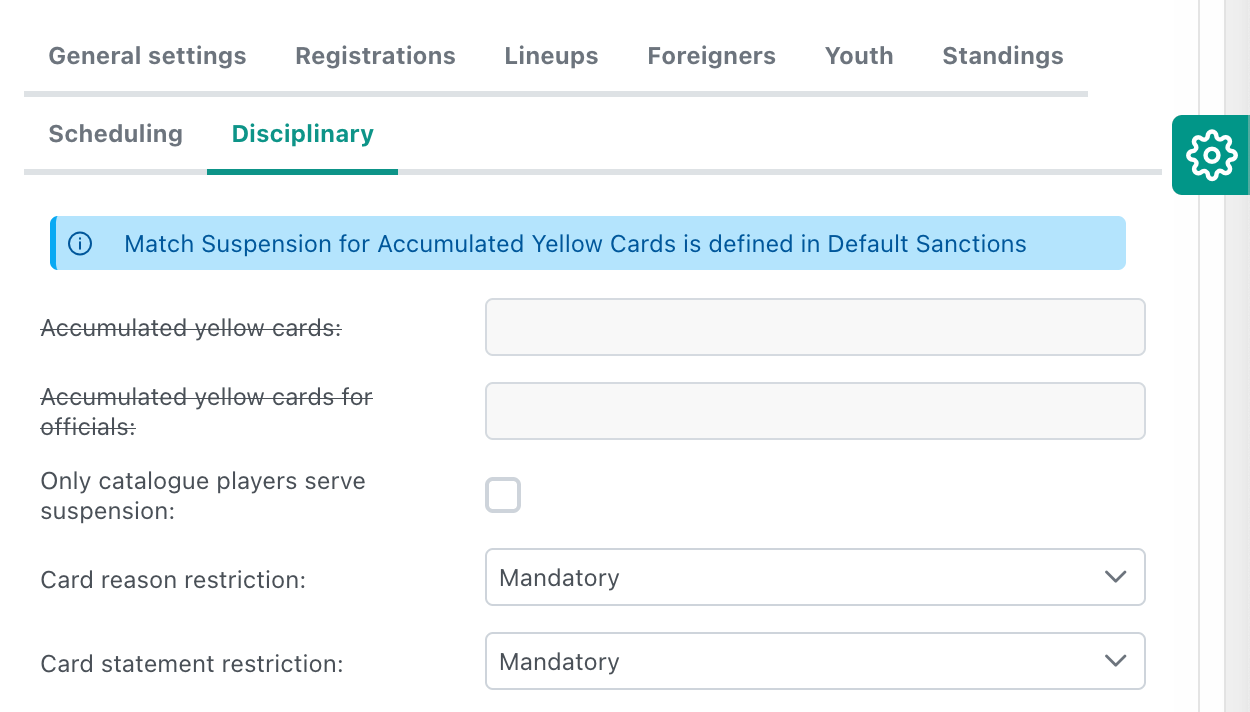Default Sanctions
In accordance with your disciplinary code, you can specify default sanctions per event type (and even per competition type). I.e. you can specify the severity and combination of sanctions for any yellow card, sin bins, or red card issued to players or team officials on the bench.
For example, if a player is issued a red card for an act of violence, he may be immediately (by default) suspended for 3 matches and also fined for 200 €. This feature gives the Superuser full transparency of the pre-defined default sanctions and allows full editing capability.
You can access this tool in the COMET Admin App (add /appadmin to your COMET homepage address) → Competition → Default Sanctions menu, where you will find tabs for defining Default Sanctions for each of the 6 Event Types: Yellow, Second Yellow and Red, separately for Players and Team Officials. In case your COMET Tenant has Sin Bins enabled, then two additional tabs will appear (Sin Bin and Second Sin Bin).

Add a New Default Sanction
In the Default sanctions tab under the Competition, select an event type for which you want to add a new sanction from the tabs above, and then click on the Add button on the right side of the screen. The dialog form offers you helpful hints/explanations of what each field represents so that you can choose or type the correct information. To read the explanation, position your mouse over the question mark symbol ❔ next to the field name.
Here is an explaination of all fields:
ID - automatically generated
Competition Type (optional) - select a competition type from the drop-down, or leave it empty if this should be a general/tenant-level Default Sanction
Card/Event type - this field is prefilled according to the Tab/Type under which a new default section is being created (e.g. Red Card)
Reason (optional) - select a Reason from the drop-down. If a reason is selected, the default sanction relates only to the match event with that reason, e.g. Red Card for reason=Violent Conduct.
Order number (optional) - allows specifying different default sanctions based on the occurrence of the same match event type in that Competition (including all Sibling Competitions). For example, the sanction for the first red card in competition may be 1 match and 100 EUR, and for the second one it can be 2 matches and 200 EUR.
Max Matches (optional)- this field presents a maximum number of matches in competition for which accumulated cards will trigger a sanction → see more in the following paragraph
Sanction type - select one sanction type from the drop-down. Most common types are Monetary Fine and Match Suspension.
Value - integer value, e.g. defining number of matches for Match Suspension, or amount to pay in tenant-defined currency for Monetary Fine
Date from offset (optional) - Sanction Date From from will be moved days defined here from the date of the match. E.g. in case of 1, the start date of the sanction will be Match Start Date+1
Article (optional) - used as Article on disciplinary case
Suspension scope - the suspension scope refers to the scope of the match(es) where the player or team official will be suspended.
Serving scope - only for Match Suspension - the serve scope refers to the scope of the match(es) where the player or team official will serve their matches
Immediate sanction - immediate sanctions get automatically closed. It never becomes active. E.g it is used for monetary fees which are not collected nor tracked in the system
You can see all sanctions for some competition types by selecting this competition type from the drop-down under the specified event type.
Competition Type
You can define a set of default sanctions specific to any Competition Type, in addition to general default sanctions specified at Tenant level (Competition Type=Null). E.g. you may have special rules for certain professional-level competitions with stricter sanctions and higher fines, while all other competitions can have a milder generic set of rules.
For each Event Type, the system logic looks first for competition type-specific rules, and if at least one active Default Sanction exists for that Event Type and that Competition Type, it only considers competition type-specific rules.
If NO active Default Sanction exists for that Event Type and that Competition Type, then system logic looks for general rules for that Event Type at the COMET Tenant level (Competition Type=Null) and applies those if found.
If none found, no case nor sanction is created.
After resolving whether to use competition type-specific or generic (Competition Type=null) configuration, the system will now consider the reason of the match event (e.g. the reason of the red card)
Reason
You can define a set of default sanctions specific to the reason of a card, e.g. in case of player red card, you can have stricter sanction for violent conduct or spitting, then for Denying Obvious Goal Scoring Opportunity (DOGSO)
The system will look first for reason-specific rules, and if at least one active Default Sanction exists for the reason of the match event in question, it will only consider reason-specific rules.
If NO active Default Sanction exists for that reason, then system logic looks for Default Sanctions with Reason=Null, and applies those if found.
If none found, no case nor sanction is created.
After resolving whether to use:
competition type-specific or generic (Competition Type=null) configuration,
reason-specific or generic (Reason=null) configuration
the system will now consider the order of the match event for that player or team official in that Competition (including all sibling competitions).
Order
If your disciplinary code specifies an ever-increasing set of sanctions based on the order number of the card, then you must enter a new row for each event type + order number + sanction combination (e.g., 1st yellow card = 5 $, 2nd YC = 10 $, 3rd YC = 15 $, 3rd YC = 1 match suspension, etc.).
The system will look first for order-specific rules, and if at least one active Default Sanction exists for the order/occurence of that macth event in question, it will only consider reason-specific rules.
If NO active Default Sanction exists for that order, then system logic looks for Default Sanctions with Order=Null, and applies those if found.
If none found, no case nor sanction is created.
Cases and sanctions are automatically created based on Defautl Sanctions, at the moment when the match is set to PLAYED. If there is more than one Default Sanction applicable for a specific event, one case with more sanctions will be created.
Max Matches
A quite common requirement for accumulated yellow cards is that they can be "forgiven" if they were collected over a relatively long period of time. For example, in some competitions, 5 yellow cards lead to a match suspension only if they were collected in the first half-season (e.g., 19 matches). If a player collects 5 yellow cards in 25 matches, this will not lead to a match suspension.
For that purpose, an optional Max Matches field was added to the Default Sanction entity for yellow cards. If that field is set, that Default Sanction will lead to an actual sanction only if the cards were accumulated in the number of matches in that competition lower or equal to Max Matches.
This optional attribute (number) is not visible on the list, just in the Default sanction detail, when adding or editing.
Applicable Default Sanctions
In COMET UI applicable default sanctions are showed in all competitions no matter if system parameter is turned ON or OFF in tenant since the system parameter is relevant only for Accumulated Yellow Cards match suspensions.
The applicable default sanctions are not showed in international or inactive competitions.
On the competition form in the “Disciplinary” tab, when competition type is selected for the competition, the expandable panel “Default sanctions” shows up:

The table of default sanctions may be filtered by card type and this filter represents the tabs of “Default sanctions” in Administration application. The table footer contains the legend explaining the data in the table.
Own settings - colors row in blue if default sanction is competition type specific
Inherited settings - colors row in grey if default sanction is inherited from tenant/generic (competition type=null). Specific and general/inherited settings never mix for same event type.
Accumulated yellow cards - emphasizes the default sanction which is a match suspension due to a number of (team official) accumulated cards
Default Sanctions for Accumulated Cards
There are two distinct methods that COMET can use for configuring Match Suspensions based on accumulated single yellow cards:
Competition Settings: defined in Disciplinary Tab on the specific Competition Detail page, by entering the number of unserved cards, leading to one match suspension.
Default Sanctions: defined with Default Sanctions for Tenant or specific Competition Type, by entering a Match Suspension defualt sanction for yellow cards with specific order.
Each COMET Tenant can choose which method to use, but cannot use both at the same time as it would lead to redundancy and duplication. In this article we will focus on Default Sanctions method, and its differences as opposed to Competition Settings.
Definition
If Default Sanctions are selected, then
If the Default Sanction entires need to be entered with specific order and sanction type=Match Suspension. In the example below, after receiving its 5th card, player will be suspended for 1 match, after the 10th card it will be 2 matches, etc.

It will NOT be possible to update the fields Accumulated yellow cards and Accumulated yellow cards for team officials in Competition Settings. Even if something was entered there (previous configuration/data), it would not be considered. Only Default Sanctions would be taken into account

Suspension Method
If Default Sanctions are selected then, when the match is set to PLAYED, an actual Disciplinary Case is created with a sanction of type=Match Suspension (and any other sanction defined, e.g. a monetary fee).
This is beneficial as:
all match suspensions are stored and displayed consistently in the same form. Otherwise if using Competition Settings, suspensions for accumulated cards are treated using Card Trackers, which is different from second yellow cards and red cards, which are always managed with Disciplinary Cases.
all sanctions for single yellow cards are stored and displayed consistently in the same form. Otherwise if using Competition Settings, match suspensions for accumulated cards are treated using Card Trackers, which is different from monetary fees, which are always managed with Disciplinary Cases.
suspension can increment for recidivists, e.g. you can put different value for 3rd, 6th, 9th card. Otherwise if using Competition Settings, it is always one match suspension.
Suspension and Serving Scope can be selected on Default Sanctions. Otherwise if using Competition Settings, suspension scope is always Competition.
Max Matches feature can only be applied on Default Sanctions, and cannot be defined in Competition Settings.
The benefits of Competition Settings as opposed to Default Sanctions, are simplicity and the fact that you can configure it for each specific competition. Based on our analysis, it is questionable whether simultaneous competitions of same type should ever have different disciplinary configuration. If indeed needed, they could always be split into two competition types.
Other Considerations
If Default Sanctions are selected then the related disciplinary reports have the following logic:
Pending Suspensions
Active sanctions are fetched, and pending card trackers are not counted, which is only relevant if Competition Settings and Card Trankers are used
the number in the yellow card box is the order number of default sanction based on which the sanction is created. Otherwise if using Competition Settings, it is the number of pending card trackers
Accumulated Yellow Cards
it shows the numbers of all active card trackers in the (parent) competition. Otherwise if using Competition Settings, it shows the numbers of pending card trackers in the (parent) competition if the system parameter is OFF
Specifically this means that if a player has collected 7 cards, and has already served the suspension after 5th accumulated card, he will show up as having 7 cards (active). Otherwise if using Competition Settings, he will show up as having 2 cards (pending).
Cards and Suspensions
the counter of accumulated yellow cards (active card trackers) is never reset. Otherwise if using Competition Settings, served accumulated card suspension resets the counter of accumulated yellow cards
Specifically this means that if a player has collected 7 cards, and has already served the suspension after 5th accumulated card, the yellow cards after the 5th will show up as 6th and 7th. Otherwise if using Competition Settings, they will show up as 1st and 2nd.
